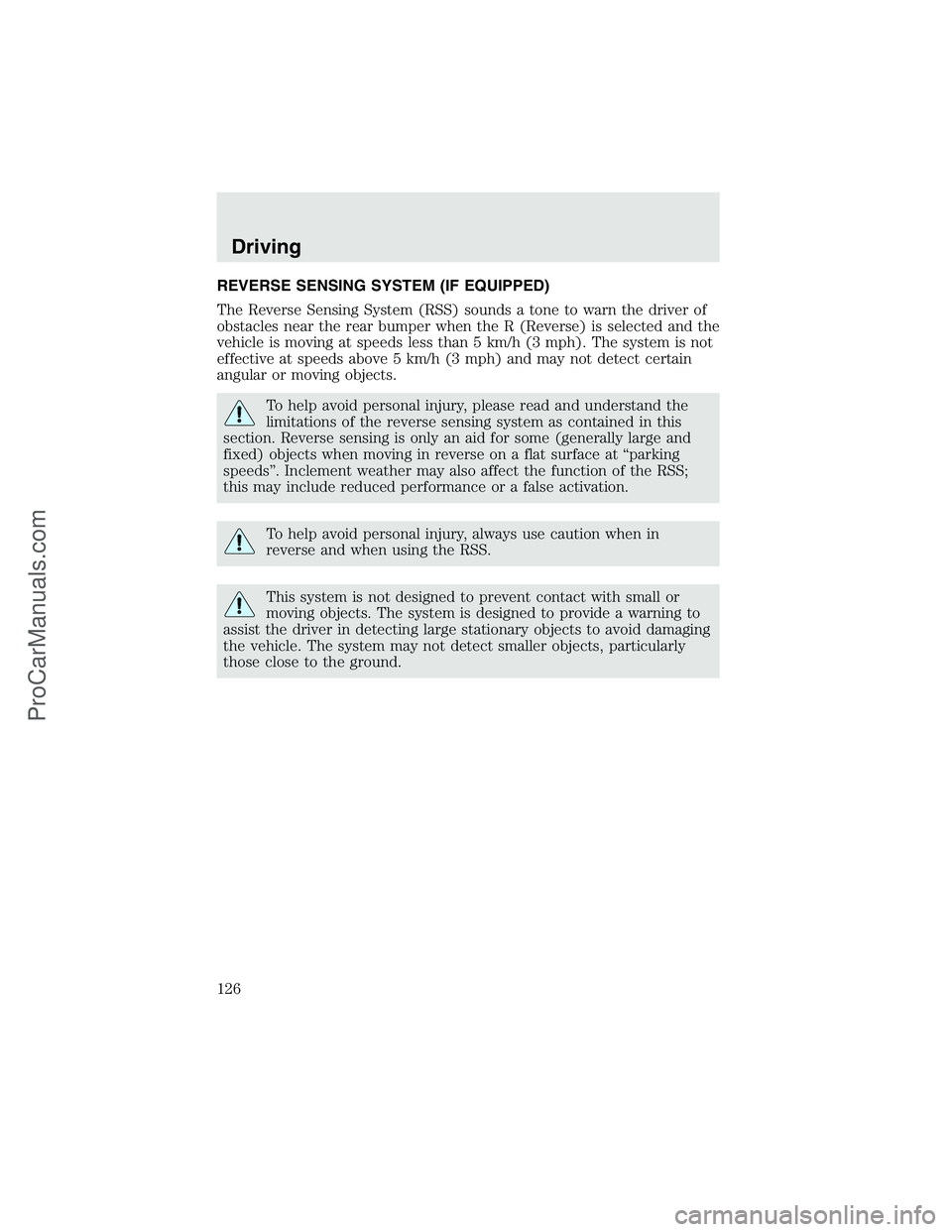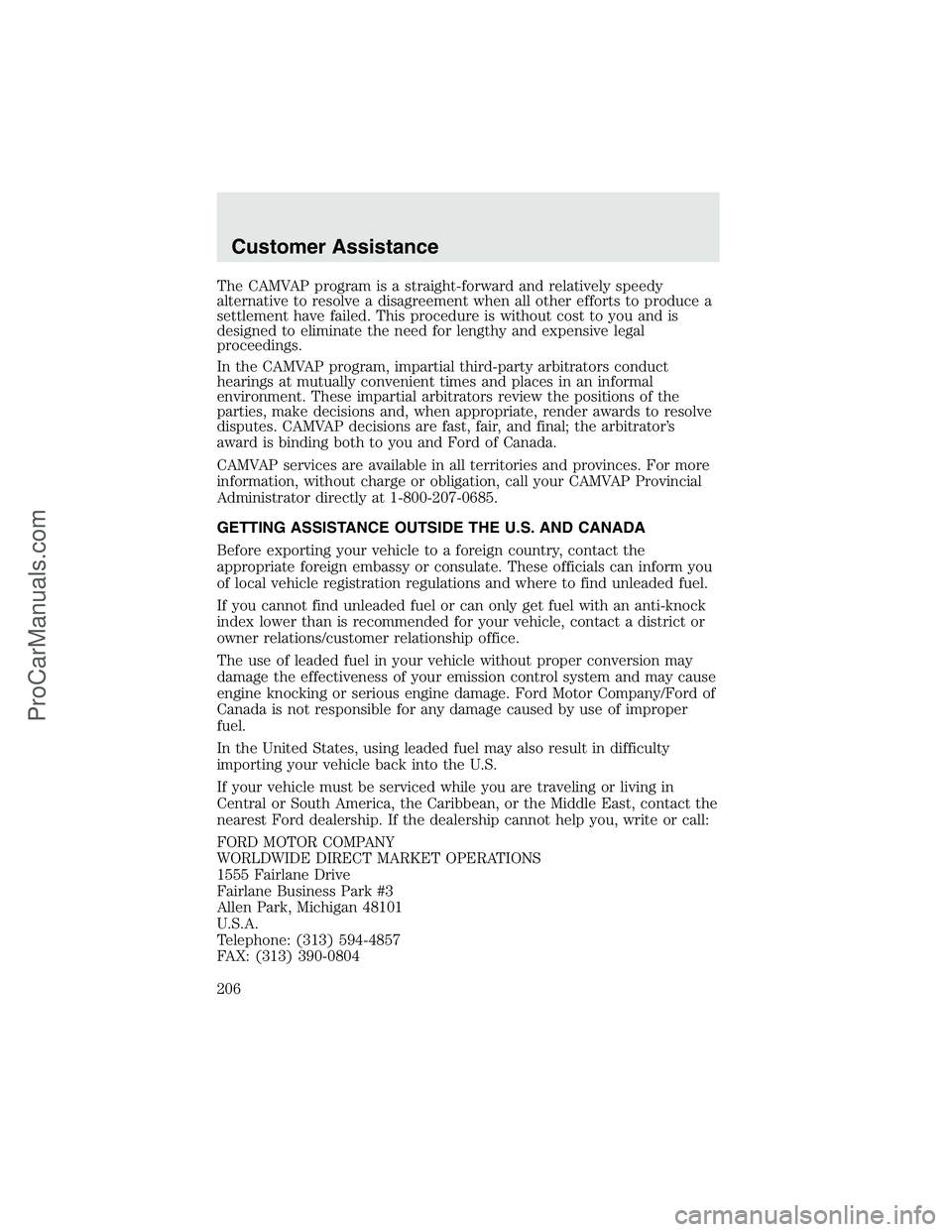Page 126 of 280

REVERSE SENSING SYSTEM (IF EQUIPPED)
The Reverse Sensing System (RSS) sounds a tone to warn the driver of
obstacles near the rear bumper when the R (Reverse) is selected and the
vehicle is moving at speeds less than 5 km/h (3 mph). The system is not
effective at speeds above 5 km/h (3 mph) and may not detect certain
angular or moving objects.
To help avoid personal injury, please read and understand the
limitations of the reverse sensing system as contained in this
section. Reverse sensing is only an aid for some (generally large and
fixed) objects when moving in reverse on a flat surface at“parking
speeds”. Inclement weather may also affect the function of the RSS;
this may include reduced performance or a false activation.
To help avoid personal injury, always use caution when in
reverse and when using the RSS.
This system is not designed to prevent contact with small or
moving objects. The system is designed to provide a warning to
assist the driver in detecting large stationary objects to avoid damaging
the vehicle. The system may not detect smaller objects, particularly
those close to the ground.
Driving
126
ProCarManuals.com
Page 195 of 280
3. Connect the negative (-) cable to the negative (-) terminal of the
assisting battery.
4. Make the final connection of the negative (-) cable to an exposed
metal part of the stalled vehicle’s engine, away from the battery and the
carburetor/fuel injection system.Do notuse fuel lines, engine rocker
covers or the intake manifold asgroundingpoints.
Do not connect the end of the second cable to the negative (-)
terminal of the battery to be jumped. A spark may cause an
explosion of the gases that surround the battery.
5. Ensure that the cables are clear of fan blades, belts, moving parts of
both engines, or any fuel delivery system parts.
Jump starting
1. Start the engine of the booster vehicle and run the engine at
moderately increased speed.
2. Start the engine of the disabled vehicle.
+–+–
+–+–
Roadside Emergencies
195
ProCarManuals.com
Page 206 of 280

The CAMVAP program is a straight-forward and relatively speedy
alternative to resolve a disagreement when all other efforts to produce a
settlement have failed. This procedure is without cost to you and is
designed to eliminate the need for lengthy and expensive legal
proceedings.
In the CAMVAP program, impartial third-party arbitrators conduct
hearings at mutually convenient times and places in an informal
environment. These impartial arbitrators review the positions of the
parties, make decisions and, when appropriate, render awards to resolve
disputes. CAMVAP decisions are fast, fair, and final; the arbitrator’s
award is binding both to you and Ford of Canada.
CAMVAP services are available in all territories and provinces. For more
information, without charge or obligation, call your CAMVAP Provincial
Administrator directly at 1-800-207-0685.
GETTING ASSISTANCE OUTSIDE THE U.S. AND CANADA
Before exporting your vehicle to a foreign country, contact the
appropriate foreign embassy or consulate. These officials can inform you
of local vehicle registration regulations and where to find unleaded fuel.
If you cannot find unleaded fuel or can only get fuel with an anti-knock
index lower than is recommended for your vehicle, contact a district or
owner relations/customer relationship office.
The use of leaded fuel in your vehicle without proper conversion may
damage the effectiveness of your emission control system and may cause
engine knocking or serious engine damage. Ford Motor Company/Ford of
Canada is not responsible for any damage caused by use of improper
fuel.
In the United States, using leaded fuel may also result in difficulty
importing your vehicle back into the U.S.
If your vehicle must be serviced while you are traveling or living in
Central or South America, the Caribbean, or the Middle East, contact the
nearest Ford dealership. If the dealership cannot help you, write or call:
FORD MOTOR COMPANY
WORLDWIDE DIRECT MARKET OPERATIONS
1555 Fairlane Drive
Fairlane Business Park #3
Allen Park, Michigan 48101
U.S.A.
Telephone: (313) 594-4857
FAX: (313) 390-0804
Customer Assistance
206
ProCarManuals.com
Page 279 of 280

Power distribution box
(see Fuses) ...............................178
Power door locks ..................65, 70
Power point .................................53
Power steering ..........................117
fluid, checking and adding ....240
fluid, refill capacity ................254
fluid, specifications .........258, 261
Power Windows ...........................53
Preparing to drive your
vehicle ........................................117
R
Radio ..........................20, 22, 25, 29
Relays ........................................177
Remote entry system .................67
illuminated entry ......................70
locking/unlocking doors ...........65
Reverse sensing system ...........126
Roadside assistance ..................175
S
Safety belts (see Safety
restraints) ........................77–81, 83
Safety defects, reporting ..........208
Safety restraints ....................77–83
belt minder ...............................85
cleaning the safety belts ..........89
extension assembly ..................89
for adults .............................78–81
for children ...............................99
lap belt ......................................84
warning light and chime ..........85
Safety seats for children ..........102
Seat belts (see Safety
restraints) ....................................77Seats ............................................72
child safety seats ....................102
cleaning ...................................213
Servicing your vehicle ..............216
Snowplowing .................8, 171–173
Spare tire
(see Changing the Tire) ...........182
Spark plugs,
specifications .....................254, 261
Special notice ................................9
ambulance conversions ..............8
diesel-powered vehicles .............8
four-wheel drive
vehicles ............................173–174
utility-type vehicles ....................8
Specification chart,
lubricants ...........................258, 261
Speed control ..............................57
Starting your
vehicle ........................110–111, 113
jump starting ..........................193
Steering wheel
tilting .........................................50
T
Tailgate ........................................64
Tires ...................................247–249
changing ..........................182, 185
checking the pressure ............249
replacing ..................................252
rotating ....................................250
snow tires and chains ............253
tire grades ...............................248
treadwear ................................248
Towing .......................................145
trailer towing ..........................145
wrecker ....................................198
Index
279
ProCarManuals.com